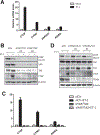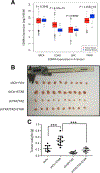Endothelin Promotes Colorectal Tumorigenesis by Activating YAP/TAZ
- PMID: 28249901
- PMCID: PMC6724531
- DOI: 10.1158/0008-5472.CAN-16-3229
Endothelin Promotes Colorectal Tumorigenesis by Activating YAP/TAZ
Abstract
Endothelin receptor A (ETAR) promotes tumorigenesis by stimulating cell proliferation, migration, and survival. However, the mechanism of ETAR in promoting tumor growth is largely unknown. In this study, we demonstrate that ETAR stimulates colon cell proliferation, migration, and tumorigenesis through the activation of YAP/TAZ, two transcription coactivators of the Hippo tumor suppressor pathway. Endothelin-1 treatment induced YAP/TAZ dephosphorylation, nuclear accumulation, and transcriptional activation in multiple colon cancer cells. ETAR stimulation acted via downstream G-protein Gαq/11 and Rho GTPase to suppress the Hippo pathway, thus leading to YAP/TAZ activation, which was required for ETAR-induced tumorigenesis. Overall, these results indicate a critical role of the YAP/TAZ axis in ETAR signaling. Cancer Res; 77(9); 2413-23. ©2017 AACR.
©2017 American Association for Cancer Research.
Conflict of interest statement
Disclosure of Potential Conflicts of Interest
K.-L. Guanhas ownership interest (includingpatents) inVivace. No potential conflicts of interest were disclosed by the other authors.
Figures






Similar articles
-
Multifaceted regulation and functions of YAP/TAZ in tumors (Review).Oncol Rep. 2018 Jul;40(1):16-28. doi: 10.3892/or.2018.6423. Epub 2018 May 8. Oncol Rep. 2018. PMID: 29749524 Free PMC article. Review.
-
Thromboxane A2 Activates YAP/TAZ Protein to Induce Vascular Smooth Muscle Cell Proliferation and Migration.J Biol Chem. 2016 Sep 2;291(36):18947-58. doi: 10.1074/jbc.M116.739722. Epub 2016 Jul 5. J Biol Chem. 2016. PMID: 27382053 Free PMC article.
-
YAP/TAZ Initiates Gastric Tumorigenesis via Upregulation of MYC.Cancer Res. 2018 Jun 15;78(12):3306-3320. doi: 10.1158/0008-5472.CAN-17-3487. Epub 2018 Apr 18. Cancer Res. 2018. PMID: 29669762
-
The Hippo pathway terminal effector TAZ/WWTR1 mediates oxaliplatin sensitivity in p53 proficient colon cancer cells.BMC Cancer. 2024 May 14;24(1):587. doi: 10.1186/s12885-024-12316-4. BMC Cancer. 2024. PMID: 38741073 Free PMC article.
-
The emerging roles of YAP and TAZ in cancer.Nat Rev Cancer. 2015 Feb;15(2):73-79. doi: 10.1038/nrc3876. Epub 2015 Jan 16. Nat Rev Cancer. 2015. PMID: 25592648 Free PMC article. Review.
Cited by
-
LOXL1 modulates the malignant progression of colorectal cancer by inhibiting the transcriptional activity of YAP.Cell Commun Signal. 2020 Sep 10;18(1):148. doi: 10.1186/s12964-020-00639-1. Cell Commun Signal. 2020. PMID: 32912229 Free PMC article.
-
Regulation of the Hippo pathway in cancer biology.Cell Mol Life Sci. 2018 Jul;75(13):2303-2319. doi: 10.1007/s00018-018-2804-1. Epub 2018 Mar 30. Cell Mol Life Sci. 2018. PMID: 29602952 Free PMC article. Review.
-
Proteasome Inhibition Suppresses KIT-Independent Gastrointestinal Stromal Tumors Via Targeting Hippo/YAP/Cyclin D1 Signaling.Front Pharmacol. 2021 May 6;12:686874. doi: 10.3389/fphar.2021.686874. eCollection 2021. Front Pharmacol. 2021. PMID: 34025442 Free PMC article.
-
β-arrestin1/YAP/mutant p53 complexes orchestrate the endothelin A receptor signaling in high-grade serous ovarian cancer.Nat Commun. 2019 Jul 19;10(1):3196. doi: 10.1038/s41467-019-11045-8. Nat Commun. 2019. PMID: 31324767 Free PMC article.
-
Targeting tumor-stroma communication by blocking endothelin-1 receptors sensitizes high-grade serous ovarian cancer to PARP inhibition.Cell Death Dis. 2023 Jan 5;14(1):5. doi: 10.1038/s41419-022-05538-6. Cell Death Dis. 2023. PMID: 36604418 Free PMC article.
References
-
- Barton M, Yanagisawa M. Endothelin: 20 years from discovery to therapy. Can J Physiol Pharmacol 2008;86:485–98. - PubMed
-
- Luscher TF, Barton M. Endothelins and endothelin receptor antagonists: therapeutic considerations for a novel class of cardiovascular drugs. Circulation 2000;102:2434–40. - PubMed
-
- Wu MH, Chen LM, Hsu HH, Lin JA, Lin YM, Tsai FJ, et al. Endothelin-1 enhances cell migration through COX-2 up-regulation in human chondrosarcoma. Biochim Biophys Acta 2013;1830:3355–64. - PubMed
-
- Bagnato A, Spinella F. Emerging role of endothelin-1 in tumor angiogen- esis. Trends Endocrinol Metab 2003;14:44–50. - PubMed
MeSH terms
Substances
Grants and funding
LinkOut - more resources
Full Text Sources
Other Literature Sources

